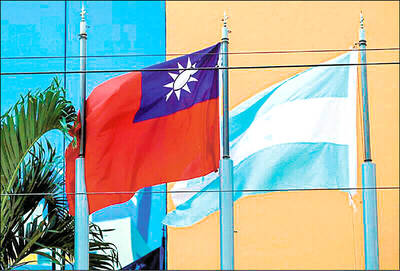People may soon be able to detect cancer at home using a simple kit that employs a gold nano-particle bio-sensing method, National Chia Tung University researchers said yesterday.
“Gold nano-particles [nanogold] are a substance that has been made since ancient times,” said Lin Chih-sheng (林志生), a professor at the university’s Institute of Molecular Medicine and Bioengineering.
“Suspended in buffer fluids, the minuscule particles of gold appear bright red,” Lin said, adding that nanogold could be used as a bio-sensor because it creates a solution when the particles are laden with other substances that changes color upon reaction with certain target bio-substances.
“For example, nanogold has been used in pregnancy test kits,” Lin said.
Last year, Lin and his students received the silver medal for the Industrial Development Bureau’s “2008 Crazy Idea King of Application — Biotechnology Research and Development Creative Application Competition” for developing nanogold into a detector capable of gauging matrix metalloproteinases (MMPs) abnormality in blood. The team’s paper has been accepted by several international journals, he said.
“Preliminary analysis has shown that MMPs, a protein, is closely related to tumor cell migration and invasion,” Lin said.
By definition, any tumor with self-limited growth is benign, whereas a tumor that transfers or migrates to other parts of the body is called cancer, Lin said.
“When coated with gelatin, gold nano-particles are separate in the buffer solution and appear red,” Lin’s team found.
“However, when gelatin-coated gold nano-particles encounter MMPs in the solution, the MMPs cut through the gelatin, which in turn exposes the nanogold so that the particles aggregate into bigger clusters and the solution turns a blue color,” he said.
Currently, MMP analysis in blood requires a lab zymography (usually in hospitals), which is complex and time-consuming, Lin said. If more studies can prove that MMPs indeed are related to tumor cell migration, his MMP bio-sensor could be developed into a simple kit to detect cancer.
“With a small drop of blood, people at risk will be able to do the test at home,” he said.

Chinese Nationalist Party (KMT) Chairman Eric Chu (朱立倫), spokeswoman Yang Chih-yu (楊智伃) and Legislator Hsieh Lung-chieh (謝龍介) would be summoned by police for questioning for leading an illegal assembly on Thursday evening last week, Minister of the Interior Liu Shyh-fang (劉世芳) said today. The three KMT officials led an assembly outside the Taipei City Prosecutors’ Office, a restricted area where public assembly is not allowed, protesting the questioning of several KMT staff and searches of KMT headquarters and offices in a recall petition forgery case. Chu, Yang and Hsieh are all suspected of contravening the Assembly and Parade Act (集會遊行法) by holding

PRAISE: Japanese visitor Takashi Kubota said the Taiwanese temple architecture images showcased in the AI Art Gallery were the most impressive displays he saw Taiwan does not have an official pavilion at the World Expo in Osaka, Japan, because of its diplomatic predicament, but the government-backed Tech World pavilion is drawing interest with its unique recreations of works by Taiwanese artists. The pavilion features an artificial intelligence (AI)-based art gallery showcasing works of famous Taiwanese artists from the Japanese colonial period using innovative technologies. Among its main simulated displays are Eastern gouache paintings by Chen Chin (陳進), Lin Yu-shan (林玉山) and Kuo Hsueh-hu (郭雪湖), who were the three young Taiwanese painters selected for the East Asian Painting exhibition in 1927. Gouache is a water-based

Taiwan would welcome the return of Honduras as a diplomatic ally if its next president decides to make such a move, Minister of Foreign Affairs Lin Chia-lung (林佳龍) said yesterday. “Of course, we would welcome Honduras if they want to restore diplomatic ties with Taiwan after their elections,” Lin said at a meeting of the legislature’s Foreign Affairs and National Defense Committee, when asked to comment on statements made by two of the three Honduran presidential candidates during the presidential campaign in the Central American country. Taiwan is paying close attention to the region as a whole in the wake of a

OFF-TARGET: More than 30,000 participants were expected to take part in the Games next month, but only 6,550 foreign and 19,400 Taiwanese athletes have registered Taipei city councilors yesterday blasted the organizers of next month’s World Masters Games over sudden timetable and venue changes, which they said have caused thousands of participants to back out of the international sporting event, among other organizational issues. They also cited visa delays and political interference by China as reasons many foreign athletes are requesting refunds for the event, to be held from May 17 to 30. Jointly organized by the Taipei and New Taipei City governments, the games have been rocked by numerous controversies since preparations began in 2020. Taipei City Councilor Lin Yen-feng (林延鳳) said yesterday that new measures by